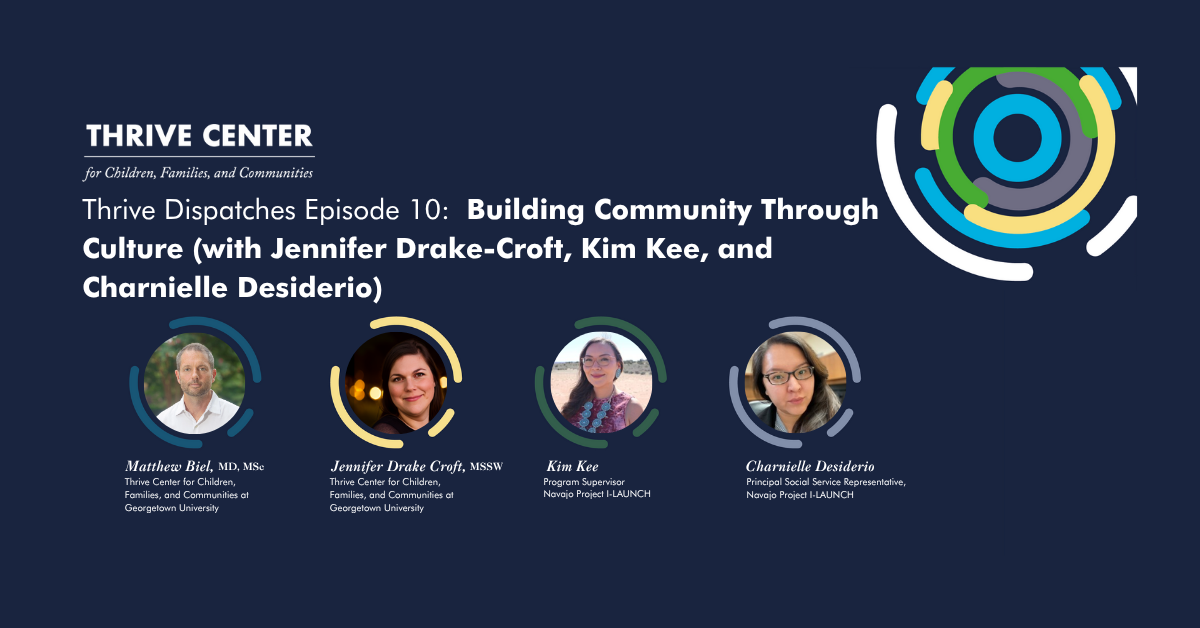Thrive Dispatches Episode 10: Building Community Through Culture with Jennifer Drake-Croft, Kimberly Kee, and Charnielle Desiderio
This week’s Thrive Dispatches Podcast is a two-part episode about the impact of authentic partnerships rooted in cultural wisdom and community values.
In part one, Dr. Matt Biel speaks with Jennifer Drake-Croft whose work in infant and early childhood mental health exemplifies the Thrive Center’s commitment to community-led solutions. They discuss Jennifer’s work on Project Indigenous LAUNCH.
In part two, Jennifer speaks the two community leaders from Navajo Nation, Kimberly Kee and Charnielle Desiderio who share how practices were thoughtfully adapted to honor Indigenous ways of knowing. Their five-year SAMHSA-funded initiative demonstrates the remarkable outcomes possible when programs emerge from, rather than impose upon, community values and traditional practices.
Through their adaptation of Positive Indian Parenting to Positive Diné Parenting, incorporating sacred teachings about cradleboards and the four directions, Kimberly and Charnielle illuminate how cultural practices that have sustained communities for millennia contain sophisticated understandings of child development, family systems, and community wellness. Their work transcends simple cultural adaptation to reveal how Indigenous knowledge systems offer essential frameworks for supporting children’s social-emotional development.
This episode demonstrates that sustainable change occurs when communities make programs their own, creating interventions that reflect their values while meeting their children’s developmental needs.
For questions, comments, or ideas for future episodes, please email us at: thrivecenter@georgetown.edu.
Summary:
In this excerpt, Charnielle and Kim share the cultural and developmental wisdom embedded in traditional Navajo cradleboard practices—wooden carriers that secure infants close to caregivers’ bodies while allowing them to observe and participate in daily family life—revealing how this ancient practice embodies sophisticated understanding of attachment, sensory development, and community integration that contemporary child development science is only beginning to fully appreciate.
This interview has been edited for length and clarity.
Charnielle: And so the cradleboard in our culture, it’s supposed to be useful and practical. It was really a bonding element between mom and baby. And it was also mobile too, that if mom needed to do her household chores, then she was able to kind of carry the cradleboard around. And of course it was helping baby with sleeping and also prevented SIDS, things like that. And the neat thing about the cradleboard is that it was a male’s responsibility to create the cradleboard. He had to go out into, you know, the woods, into nature and he had to chop down the tree. He had to be the one to create the cradleboard.
Kimberly: And they’re able to see and be a part of their world rather than being like in a crib in a separate room, not being able to see everybody or see what everyone’s doing. So they’re really integrated into the family’s life.
Jen: I love just the intertwining of all of the things that help ensure that a baby’s environment is as enriching, is as nourishing as promoting attachment. You know, that there is this engagement from multiple family members in terms of this process, you know, that’s both practical but also is so developmentally appropriate, right? Like, is providing those opportunities that you all described of learning about their world, of engaging in back and forth interaction with their caregivers so that they can optimally develop in the context of relationship.
Listen to the full episode
